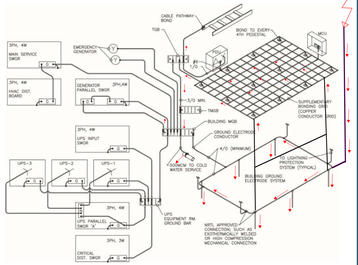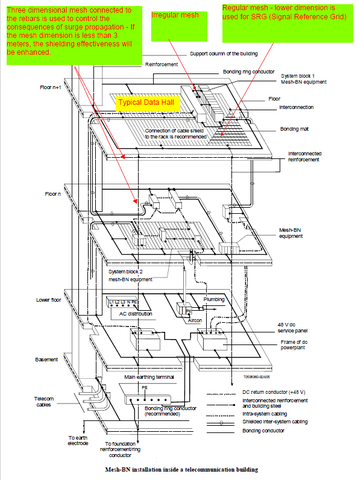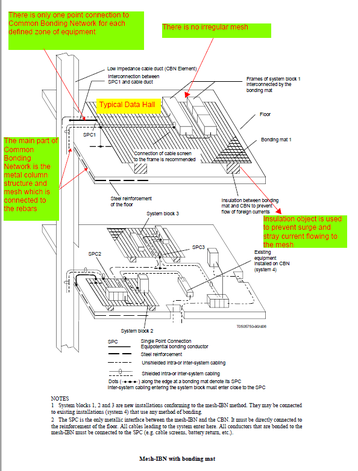Improving the efficiency and reliability of data centers is a key area of concern for design teams working on data center projects, so it is paramount that standards that outline data center requirements and building envelope protection are set for them.
All the components in a power distribution network inside a data center may affect one or both of the aforementioned factors of efficiency and reliability. Industry standards provide advice, recommendations, and obligations that design teams must respect and uphold to keep a data center efficient and operational.
The recommendations for the types of earthing and bonding systems for a data center are mainly referenced for controlling the amount of voltage differences within a reasonable limit to avoid damaging IT equipment categorized as vital and vulnerable equipment within a data center building.
Failing to control surge propagation in a data center could have a significant impact on the reliability of the data center’s distributed system, and affect the failure rate of critical components leading to loss of service, ultimately affecting the reliability of the entire data center and equipment system.
How to control surge propagation
Controlling surge propagation in a data center involves several key components that must be completed in the design and consultancy phase of the build, and carried out by certified electrical engineers.
1. Bonding networks: Being well informed of the advantages and disadvantages of different types of bonding networks by working closely with your certified lightning protection installer from the initial design and consultancy phases in order to gain a greater understanding of items such as star, ring, Mesh-BN, Mesh-IBN etc.
2. Recommendations: Reviewing the standard recommendations that relate the bonding network type to the rating of each data center is a critical component of surge propagation. For this we can refer to the standards BSEN 50310- IEC 60364-5-54, IEC 60364-4-44, TIA 607C, ANSI/BICSI002 and IEC 61000-5.
3. Surge current distribution assessment: Conducting a surge current distribution assessment to find out the vulnerable point of the system is a key component of controlling surge propagation in data centers.
To conduct this assessment, the following information is required:
- How many metal underground paths are available to the remote earth. For example, water and gas piping, outside neutral connection in TN system, and so on;
- The location of the underground pop-up points to the main earthing terminals is crucial;
- The type of underground earth electrode (simple loop or mesh);
- The type of air termination network (isolated or non-isolated).
4. Backbone networks: If we choose a certain type of backbone network, it is essential to ensure that all requirements stated in the standard are met for the desired purpose. For example, if we have chosen to have a three-dimensional mesh as specified in IEC62305-4 in order to get the shielding effectiveness points, the size of the mesh needs to be less than 5x5m.
But if, for any reason, we must use a larger size of the three-dimensional mesh -- for example, 10x10m -- we need to evaluate whether it could enhance the above-ground earthing backbone adequately to extend the common bonding network (CBN) to provide an effective common impedance network, which could eliminate the use of separated containment backbones between different zones of the data hall.
If Mesh-BN has been chosen to be used as a backbone for IT equipment, the following must be taken into account:
- We must be aware of alternatives that are available to augment the Common Bonding Network (CBN). This issue relates to the type of structure that is utilised, which could be columns comprised of rebars embedded in the concrete, or metal structures mounted on a concrete pad;
- If the Mesh-BN system is selected as the system to install, the way the design of the air termination network on the roof must be taken into consideration, especially if there is a need to consider the internal down conductor. Internal down conductors are usually required for either decreasing the separation distance or in the case of restrictions on installing an appropriate mesh network that can split the lightning current into sufficient branches.
5. Lightning protection zones (LPZ’s): Identifying different LPZs and finding out if the bonding backbone is adequate is challenging. It is essential to consider operational restrictions in this instance.
6. Combination bonding networks: Generally, in big data centers, there could be a variety or combination of bonding networks due to the type of equipment and zones within the building. For example, mesh bonding for a data hall or star configuration for other equipment areas. This is because there are different expectations for various bonding networks. In data halls, in addition to the requirements for safety measures, we must control surge propagation and create a clean common impedance network.
Conclusion
In order to design effectively for surge propagation control in data centers, there are a number of key factors to take into consideration.
Along with designing to specific industry standards to instill confidence that critical electrical equipment will be available to use for the intended period and that the failure rate of the whole system will be taken under control, ensuring operational excellence for the building owner.
The main factors for surge protection distribution assessments are the types of bonding networks (Mesh-BN, Mesh-IBN, Atar), the type of structure (metal column or embedded rebars), the type of foundation electrodes, the location of the pop-up points, and the available incoming services such as water pipes, gas pipes, etc.
To ensure these are operating effectively, it is critical to work with an experienced design team on your data center project to guarantee complete building envelope protection.
To find out more about LPI Group’s lightning protection systems, earthing systems and surge protection devices, check out the company’s website
More...
-
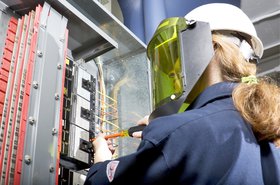
Sponsored Safety for employees: It shouldn’t be too much to ask
How a track busway power distribution system can help keep your employees – and IT equipment – safe
-

Protecting your mission critical data center from avoidable downtime
Design carefully, and employ surge protection devices
-
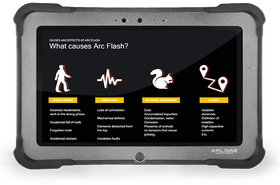
Course Arc Flash Safety


